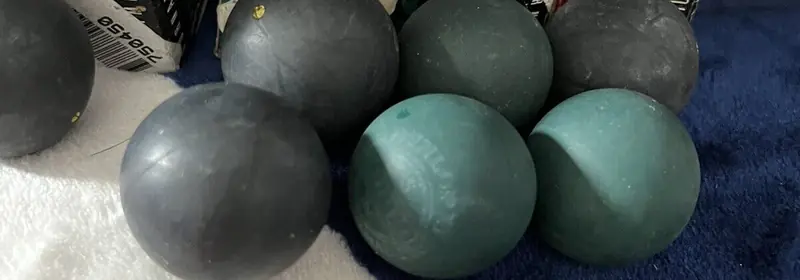26 August 2022 / 3-Min Read / Translate
Did you know that the World Squash Federation doesn’t specify a colour that a ball must be? They also only specify the “Standard Single Yellow” dot, the “Standard Double Yellow” and the “High Altitude Green” dot balls. So that not only means the red and blue dots can be ANYTHING ANY manufacturer wants, but also ANY manufacturer could create their own ball with its own coloured dot. That’s why the Dunlop red and blue dots are bigger than other manufacturers’ squash balls.
When I first started playing squash, all the squash balls were green. They were just as easy to use as the black and in some ways were easier. I’m not sure when or why they changed to black. I suspect it was due to one of two reasons. Firstly, cost, perhaps it was cheaper to have black dye than green, but that really is a pure guess. Secondly, and again it’s a pure guess, is that Dunlop wanted a way to differentiate their squash balls from other manufacturers (more on that below).

As you can see from the image below, Slazenger also made and sold some special coloured squash balls. I no longer have mine, but I do remember that the blue was the best to use. Also, while we are talking about colours, when I worked for Dunlop, I tried to convince the R&D department to make mixed colour balls. That is, taking two halves of different colours and putting them together. I suppose you know that a squash ball is constructed of two halves glued together. That’s where 99.99% of balls break: along the join.
Anyway, they said that the colours would run and it would look a mess. I argued that it would look like a tie-dye t-shirt, but they still said “No”. I also tried to get them to make neon yellow balls to replace the white pro ball, just like had been done with tennis balls, but again they said they could get the dye to look neon enough.

Back in the day, the colours of the dots were: Blue, Red White and Yellow. Then some clever person at Dunlop decided they needed a way to make their balls stand out, so they introduced the Double Yellow, which was exactly the same as a single yellow, except it had two dots ! The idea being that when people walked into a sports shop to buy squash balls, if they said they wanted a single yellow, the shop could sell them any brand, but if they asked for a double yellow, they had to sell them a Dunlop squash ball.
As I wrote recently in Which Ball Should New Players Use, the colours and number of dots don’t help new players in any way at all. Eventually, the World Squash Federation changed the dots to match Dunlop and all the manufacturers had to following, meaning the original reason for changing was negated. Who knows, perhaps Dunlop will one day release the Triple dot!
Like all rubber products, squash balls don’t last forever, even if they are kept new in boxes. Honestly, I’m not sure how long you could keep a ball before it becomes unusable. I have some new balls that are about 20 years old and they “look” like they would play okay. In fact, next time I go to the courts, I’ll try them and let you know. The boxes are probably worth just as much as the old balls.
So, the humble little black ball’s history is more colourful than you thought and I am sure there is much more to it than the little I have presented here.